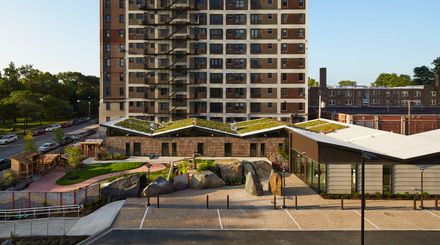
UChicago Child Development Center Stony Island
UChicago Child Development Center Stony Island
Wheeler Kearns Architects
MANUFACTURERS
Firestone Building Products, Liveroof, Oldcastle Buildingenvelope, Bark House, Belgard
STRUCTURAL ENGINEER
Thornton Tomasetti
ACOUSTICAL CONSULTANT
Threshold Acoustics
MEP
Primera Engineers
FP
Primera Engineering
PHOTOGRAPHS
Steve Hall / Hedrich Blessing
MEP/FP/CIVIL
Primera Engineering
GENERAL CONTRACTOR
Leopardo Construction
AREA
13300 Ft²
YEAR
2013
LOCATION
Chicago, United States
CATEGORY
Kindergarten, Extension
Text description provided by architect.
Inspired by an adjacent historic landscape, the University of Chicago Childcare Development Center - Stony Island integrates the natural environment with its architecture and child-centered curriculum.
Instead of creating a place dominated by synthetic play equipment and primary colors, the design allows children to be immersed in the natural world to discover first principles first-hand.
The building, with a z-shaped footprint, responds to the narrow infill site, optimizing limited sun exposure and leveraging visual connections between the interior and exterior.
Outdoor play courts, which parallel the two classroom wings, provide for age-appropriate physical challenges and exploration in a natural environment.
The eastern wing, clad in tree bark siding, provides spaces for infants and toddlers. The western wing, clad in an unpainted cement board siding, serves older children up to age five.
A gently folded roof, vegetated over its eastern half, directs light to the interior and rainwater toward the play courts.
The wings overlap at the midpoint, where a glassy lobby serves as the building’s emotional center.
Unencumbered open plan tandem classrooms are leveraged for long-term flexibility and adaptability.
Here, the University community bonds around the mission of having children learn nature’s first principles first hand, in view of a play court surrounded by monumental boulders, a gabion stone fence, and ornamental trees.
Common classroom-related support functions including teacher workstations, diaper changing, children lavatories, and toilets, are placed in a shared zone between pairs of classrooms.
The open sharing arrangement allows teachers to supervise the other classroom when needed.
The 13,300 square-foot facility is more “look-within-me” than “look-at-me.” Rather than competing with the size or glamour of the adjacent University buildings, the focus of the center remains on the child’s perspective and outdoor play.
Rainwater cascades from the roof into splash tanks. A squash house, a live willow tunnel, a trike path, and sand and water zones encourage exploration.
Different surfaces invite children to crawl, roll, ride, climb and walk—to learn about their five senses while interacting with nature.
If children learn what they live, they will not only learn from nature, but they will learn to value it. Additionally, the curriculum of the center is fully integrated with this mission.




















